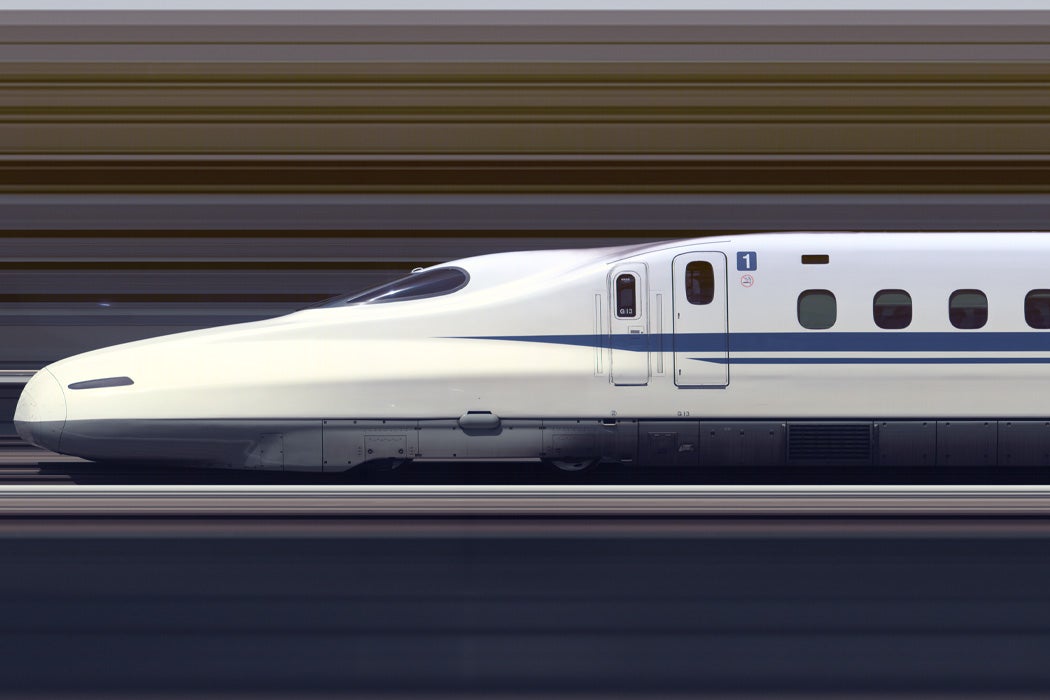Welcome to JSTOR Daily’s Planet-Conscious Weekly Summer Travel Series! From electric cruise ships to biofuel-powered jets, from agritourism to sustainable ways of interacting with wildlife, we will investigate better, more sustainable ways to travel and interact with the world.
Mark Tully, former Bureau Chief of the BBC, New Delhi, once wrote that flying always feels the same. “The same airports, the same boring boarding procedures, the same in-flight regime, from the first identical safety announcements to the last fasten your seat-belts sign.” According to Tully, air travel doesn’t really allow travelers to experience the journey or witness the culture. “A journey by air leaves the traveller as deflated as a punctured tyre,” he writes, lamenting the fact that today so many destinations aren’t reachable by other forms of travel—such as rail, for example. “The problem today is that aeroplanes and their partners in crime, automobiles, are putting other forms of travel out of business.”
Of course, before air travel became commonplace, trains were the favorite transportation method. In the United States, railroading began when the first steam trains entered service in 1830. In the mid-1890s, the train share of intercity passenger traffic reached 95%. By the second decade of the twentieth century, the country’s number of railroad tracks was at its peak. Trains were considered modern and fashionable. But when the automobiles arrived in the 1920s, they began to compete with trains—and by 1929, rail travel fell by one-third.
Airplane travel strained the railroad operations further. By the late 1950s, when the Interstate Highway System was being built and jet airplanes arrived, the railroad operations were losing money and going out of business. To prevent the extinction of passenger rail transportation, the United States government created the National Railroad Passenger Corporation, a quasi-public enterprise more commonly referred to as Amtrak. Although initially created as a for-profit company, Amtrak always relied on government subsidies to defray its operating and capital expenses—which in the past had prompted outcries to shut it down altogether.
However, for over a decade now railroad transportation has been enjoying a revival—particularly when it comes to high-speed trains that can reach about 200 miles an hour. The Chinese high-speed rail system alone carries over 4 million people daily, with its 16,000 miles of track. On that system travelling between Beijing to Shanghai—about the same distance that separates New York and Chicago—takes less than five hours. Via Amtrak, that distance would take about eighteen hours. Travelling over 1,000 miles between Beijing and Guangzhou takes eight. Powered by electricity, these high-speed trains run faster than diesel locomotives while also reducing air pollution—an important sustainability factor.
China did not invent high-speed railroad. These engineers perfected the Japanese method, invented by engineer Hideo Shima who showed that a lightweight carriage could travel at 200 miles per hour by channeling power through a motor to each of its wheels. Using that approach, Japan built its sleek, graceful trains—and debuted the first one just in time for the 1964 Summer Olympics in Tokyo. Later, France developed its own high-speed rail, TGV, according to the same principles.
In late-1990s, the Chinese Ministry of Railways ran a “Speed Up” campaign to improve its aging train system and laid a pilot set of high-speed tracks. In 2008, the government announced a giant stimulus package and upped rail investments from $49 billion to $88 billion next year, aiming to open forty-two high-speed lines within the next three years. Not since Tsar Alexander III built the Trans-Siberian Railroad had a central authority taken on such an ambitious rail project.
Today, the Chinese high speed system is the largest in the world, carrying about 800 million travelers a year, although not always smoothly—some lines are already aging and corroding, and equipment malfunctions, causing accidents. Other countries—from Russia to Brazil and from Turkey to Taiwan—built or are building similar systems.
The United States was on its way to join that list. In 2015, California governor Edmund G. Brown Jr., together with about 1,000 supporters from across the state, gathered in Fresno for the official ground-breaking for the nation’s first high-speed railroad track. The system would replace diesel trains with electric ones, reducing pollution and fossil fuel dependency. The California High-Speed Rail Authority committed to using 100% renewable sources including wind, solar, and hydroelectric power. These sleek and modern trains would carry passengers between Los Angeles and San Francisco in less than three hours, eventually zooming as far as Sacramento and San Diego. But in February 2019, the U.S. Department of Transportation cancelled its $929 million grant for California’s high-speed train travel. Governor Gavin Newsom announced plans to scale back the project and the state later sued over the money revocation.
Weekly Newsletter
It wasn’t the first time a U.S. high-speed train project ran into trouble. The Obama administration also attempted to push through a high-speed rail idea, which never took off for a variety of political reasons.
Will you ever be able to enjoy the three-hour dash between Los Angeles and San Francisco? It remains to be seen. According to local reports from California, state officials are preparing a $1.6 billion contract to be awarded for design and construction of a scaled-back version of the original L.A. to San Francisco high speed rail plan. Perhaps one day this high-speed train travel will finally catch on in the U.S. In the meantime, you can ride high-speed trains in more than twenty other countries, joining 1.6 billion other passengers a year.
Editors’ Note: An earlier version of this story suggested that the California high speed rail project had ended; in fact it is continuing despite the cancellation of government funds.







